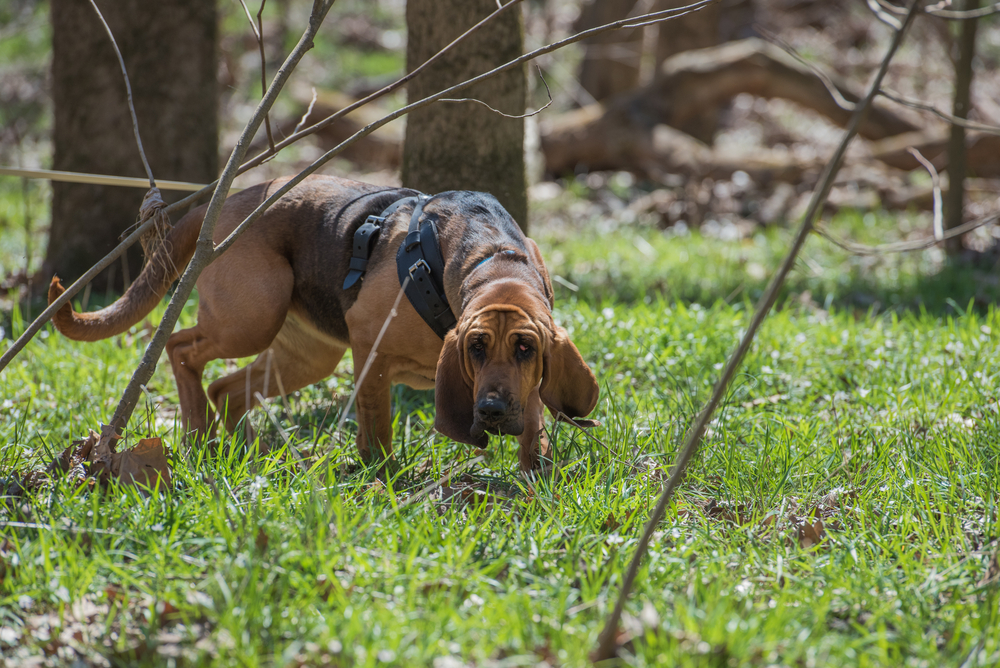Whether their heads are held high sniffing in the wind or buried under something mysteriously stinky on your morning walk, there’s no doubt a dog’s sense of smell is a key part of the way he navigates his world. It’s actually important to let your dog sniff as you stroll along, as it can help his brain generate new pathways in learning.
In fact, a dog’s sense of smell is so powerful that it can be trained to detect food allergies, certain forms of cancer, and even bedbugs! Law enforcement agencies use dogs to track criminals, narcotics, and explosives, while search-and-rescue organizations use dogs to find missing persons.
So, is one breed of dog better at using his sniffing skills than all the others? Yes. Bloodhounds, often referred to as “a nose with a dog attached,” are the breed of dog with the best sense of smell.
About bloodhounds

There’s just something lovable about the bloodhound and the permanent droopy look on their fabulously wrinkly face. These dogs can grow to more than 2 feet tall and weigh as much as 110 pounds, but they are some of the best family dogs because of their tolerance and patience.
Originally bred for hunting large game such as deer and wild boar, bloodhounds are thought to be descendants of Belgian hounds kept at the Abbey of Saint-Hubert in the Ardennes region and, as a breed, may be nearly 1,000 years old.
These affectionate, even-tempered pups generally live for 10 to 12 years with minimal health problems (although they are notorious for drooling, howling, and snoring!). The original breed name — blooded hound — is more about breeders’ protective measures to preserve the lineage than it is about actual body fluid.
Best by a nose

Why do bloodhounds have the best sense of smell? Experts say it’s because they have as many as 300 million scent receptors, which enables them to follow scent trails up to 300 hours old and up to 130 miles away. That’s in comparison to other exceptional sniffers like German shepherds, which have approximately 230 million scent receptors. For reference, a human’s olfactory membranes only contain 5 million receptor neurons.
Those fabulous wrinkles and big, floppy ears play a major part in the bloodhound’s ability to track so well, too. Their ears act as sweepers that direct odors into their noses, while scents become trapped in the wrinkles. And bloodhounds are relentless. Their muscular necks allow them to keep their nose to the ground for hours at a time without tiring.
Unique ways they serve

When a dog sniffs, the scent he takes in through his nasal passage creates an odor image, much like a photograph. This image is composed of a variety of smells, including sweat, breath, and skin. Tracking breeds like bloodhounds can use the odor image to pick up a scent trail and follow it, ignoring all other scents in the environment.
This ability makes the bloodhound perfectly suited to use their incredible sense of smell for hunting and other tasks, such as in tracking people. Law enforcement worldwide has used purebred bloodhounds to track criminals and missing people for nearly 200 years. A bloodhound’s sense of smell is so reliable, it is even admissible in a court of law.
America’s love affair with bloodhounds

One of the oldest dog breeds in Europe, bloodhounds were introduced to America in the 19th century. Their outstanding tracking skills were well matched to America’s vast wilderness and rural areas. But aside from this breed’s reputation for tracking game and locating fugitives and missing children, you may have been subliminally influenced to love their affable nature from a highly unusual source.
Evidently, Walt Disney had a love affair with bloodhounds and used them in several of his animated movies. Pluto is a bloodhound. So is Bruno, Cinderella’s dog who was transformed into a footman for her evening at the ball. And who can forget Trusty from Lady and the Tramp? Trusty’s “rusty” scent-tracking skills and loud bay helped save Tramp from certain execution for a crime he did not commit.
What is a dog’s weakest sense?

The bloodhound has an amazing sense of smell, as do most dogs, but there’s one sense that isn’t nearly as good as ours: their eyesight. Pups can’t see as many colors as we can, lacking the reds and greens that fill out our vision. They also don’t have great depth perception. On the flip side, our pets (both dogs and cats) have good night sight and will spot things in low light that we wouldn’t be able to see. While it’s normal for your bud to seem a little nearsighted, any changes to their ability to recognize things should spark a call to the vet.
So, now you know the breed of dog with the best sense of smell. Whether you own a bloodhound, know someone who was saved by a bloodhound’s exceptional tracking abilities, or simply love the bloodhounds in Disney animated features, you’re in good company. Bloodhounds are the breed of dog with the best sense of smell; their inquisitive, mild-mannered, and affectionate demeanor is every bit as impressive.



